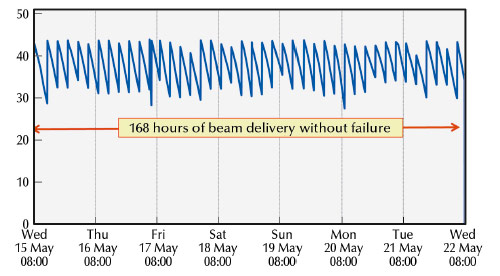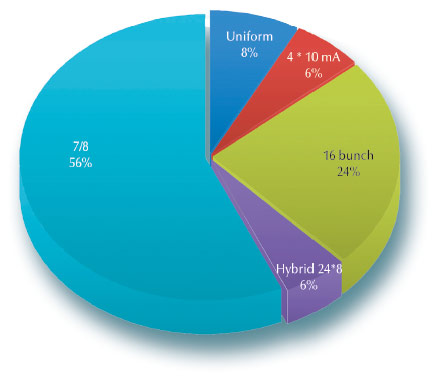- Home
- Users & Science
- Scientific Documentation
- ESRF Highlights
- ESRF Highlights 2013
- Accelerator and X-ray source
Accelerator and X-ray source
Throughout 2013, the Accelerator and Source Division has continued its efforts to ensure reliable operation, as well as implementing major upgrades to all subsystems of the accelerator complex. Many of these new developments are described hereafter.
Beam parameters of the storage ring
Table 1 presents a summary of the characteristics of the storage ring electron beam.
 |
|
Table 1: Principal characteristics of the electron beam. |
Table 2 gives the main optic functions, electron beam sizes and divergences at various source points. For insertion device source points, the beta functions, dispersion, sizes and divergences are calculated in the middle of the straight section. For bending magnets, two representative source points have been selected for each type of magnet (even or odd cell number), corresponding to magnetic fields of 0.4 T and 0.85 T. These points differ by the observation angles, of respectively 3 and 9 mrad from the entrance of the magnet.
 |
|
Table 2: Beta functions, dispersion, rms beam size and divergence at the various source points (ID = insertion device; BM = bending magnet). |
Electron beam profiles are Gaussian and the size and divergence are presented in terms of rms values. The associated full width at half maximum sizes and divergences are 2.35 times higher. Horizontal electron beam sizes and divergences are given for the multibunch filling modes and apply to almost all filling patterns, except when the current per bunch is larger than 4.5 mA, for which a slightly larger size and divergence are attained because of the increased energy spread of the electron beam.
Vertical electron beam sizes and divergences are given for a vertical emittance of 4 pm, which is now the standard for 2 x 1/3 and 7/8+1 filling modes. The vertical sizes and divergences are about 1.4 times larger in uniform filling mode (due to ion effects, which are partially corrected by the use of a vertical bunch-by-bunch feedback). To increase the lifetime of the stored beam, the vertical beam sizes and divergences are deliberately increased by about a factor of 4 in the 16-bunch, 4-bunch and hybrid filling patterns.
 |
|
Table 3: Current, lifetime, bunch length and energy spread for a selection of filling modes. |
The lifetime, bunch length and energy spread mainly depend on the filling pattern. These are given in Table 3 for a few representative patterns. Note that in both 16-bunch and 4-bunch filling patterns, the energy spread and bunch length decay with the current (the value indicated in the table corresponds to the maximum current). The bunch lengths are given for the usual radio-frequency accelerating voltage of 9 MV (8 MV for 16-bunch and 4-bunch).
Summary of accelerator operation
The exceptional five-month shutdown in 2012 made it an unusual year, with only 3540 hours of scheduled beamtime. Operation returned to normal for 2013, with 5502 hours of scheduled beam delivery for the Users (plus additional shifts for Radiation and Personal Safety System tests). Out of these scheduled 5502 hours, 5396.65 hours were delivered, which represents an accelerator availability of 98.93% This excellent figure is very close to the all-time ESRF record of 99.04% in 2009. That this was achieved was thanks to the absence of any significant failures in 2013. Indeed, the longest failure lasted less than 3 hours and can be described as a tricky diagnostic event, during a weekend, that required the intervention of several experts, with the eventual discovery of abnormal behaviour on the limit switch of a manual valve.
Similarly, the mean time between failures (MTBF) of 79.7 hours is the second best MTBF ever obtained at the ESRF (the record is 107.8 hours in 2011). In April, during the second run of the year, a series of beam position interlocks (BPIs) spoilt the MTBF. Due to the random aspects of these interlocks, it took about 2 weeks and some effort to locate the origin, which was a corrector power supply oscillating for a short period at random moments. This abnormal behaviour was tracked down to a design flaw in a newly installed corrector-family power supply.
 |
|
Fig. 158: Uninterrupted beam delivery for 168 hours in 4 * 10 mA filling mode during May (Run 2013-02; week 8 [4 * 10 mA]). |
The noticeable absence of repetitive events (especially during Run 3 and 5 when the MTBF largely exceeded 100 hours) resulted in many weeks in which the beam was delivered without any interruption. As an example, there were 21 periods with more than 100 hours of beam delivery without a single interruption, including 2 periods of 168 hours (see Figure 158) and one of 167 hours. An overview of the year is presented in Table 4.
 |
|
Table 4: Overview of storage ring operation in 2013. |
In 2013, three major upgrades took place in the storage ring: the commissioning of the first 7 m straight section in cell 23 (winter 2012/2013 shutdown), the installation of two prototypes of higher order mode (HOM)-damped RF cavities in the same cell (summer 2013 shutdown) and the successful installation of a 2.5 m-long in-vacuum undulator upstream of the ID16 straight section. Two newly-installed RF cavities, which have been running in both passive and active modes, have had no negative effects on the operation of the accelerators.
Filling patterns
Figure 159 presents the distribution of filling modes delivered in 2013. This distribution of modes has not drastically evolved over the last four years, when the 7/8+1 filling mode was introduced. This mode remains the best compromise for Users who need intensity and/or time-structure. The uniform mode remains mainly for the need of specific experiments on one beamline.
 |
|
Fig. 159: Distribution of the various filling modes in 2013. |
It is worth noting that during machine dedicated time (MDT), several shifts were used with the beamlines to assess the top-up mode in 16-bunch with refills every 10, 20 and 30 minutes. Many scientists expressed their enthusiasm thanks to the excellent results obtained. Details are given later in the article on this subject.



